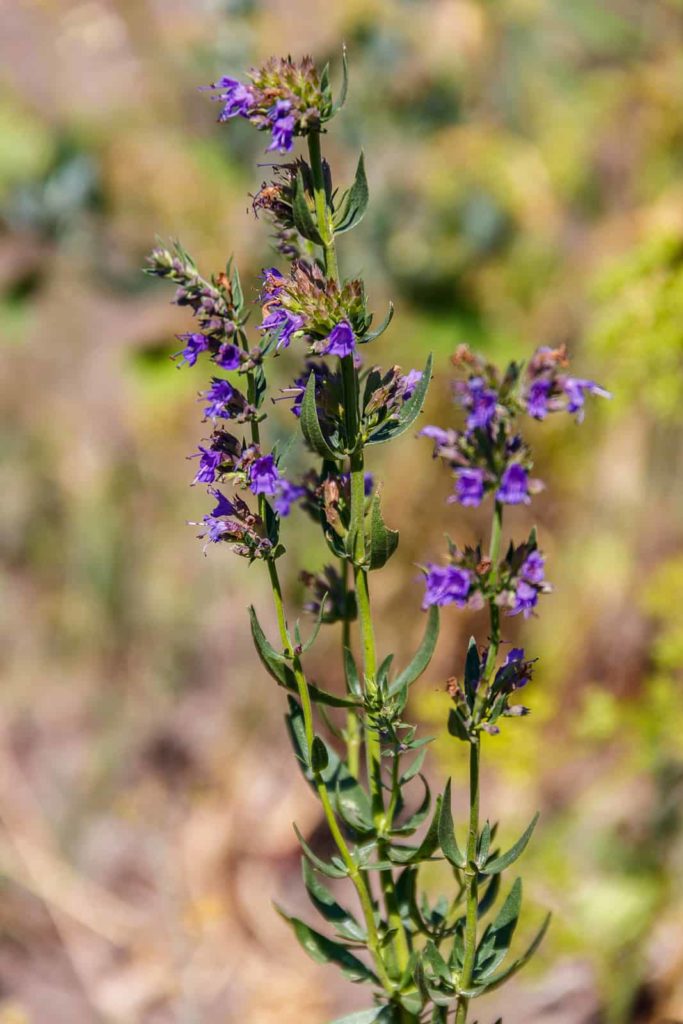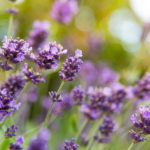Hyssop herb is a pretty compact perennial with spikes of blue and violet flowers. It is just at home in the perennial garden as it is in the herb garden. Hyssop is a member of the mint family. It can be used much like mint but its minty flavor is stronger than most mints so it should be used sparingly. Add hyssop to salads, and fruit dishes—especially cranberries, soups, and stews.
Here is your complete guide to growing hyssop.
Where to plant hyssop
- Best location: Hyssop grows best in full sun but will tolerate partial shade.
- Soil preparation: Plant hyssop in compost-rich, well-drained soil. Add aged compost or commercial organic planting mix to the planting area ahead of planting. Hyssop grows best in a soil pH of 7.0 to 8.0—slightly alkaline.
Related articles:
- How to Grow Herbs
- How to Start an Herb Garden
- Best Herbs for Container Growing
- Herbs for Cool Season Growing
- Grow 20 Herbs for Cooking

When to plant hyssop
- Seed starting indoors: Sow hyssop seed indoors in early spring just a week or so before the last frost. Start seed in flats under fluorescent lights. Germination takes about 14 days.
- Transplanting to the garden: Transplant hyssop outdoors in mid-to late spring after the last frost.
- Outdoor planting time: Hyssop can be grown from seed, division, or stem cuttings. Sow seed outdoors after the last spring frost. Seeds also can also be sown in autumn. Start plants from cuttings in late spring or early fall. Start plants from root divisions in early spring or late summer.
How to plant hyssop
- Planting depth: Sow seeds ¼ inch deep. Cover seeds lightly.
- Spacing: Space hyssop plants 12 to 18 inches apart.
- How much to plant: Grow 2 hyssop plants for cooking; grow 10 to 20 plants for tea and preserving.
Companion planting hyssop
- Companion planting: Grow hyssop with lavender, rosemary, garlic chives, and catmint. Hyssop repels flea beetles and other pests; it lures cabbage moths so it can be used as a trap plant. Hyssop attracts bees, butterflies, and hummingbirds. Plant hyssop near beehives; the collected nectar will flavor the honey. Hyssop is said to increase the yield of grapevines. Radishes are said to suffer if planted near hyssop.
Watering and feeding hyssop
- Watering: Let the top inch of the soil dry between waterings. Do not overwater hyssop. Hyssop can tolerate drought. It will thrive with light, even watering.
- Feeding: Feed hyssop compost tea or dilute fish emulsion a couple of times during the growing season.
Hyssop care and maintenance
- Care: Remove faded hyssop flowers to prolong bloom time and encourage bushy growth. Renew plants by cutting them back by half or more in early spring or late fall; this will encourage more flowering the second year. Hyssop should be divided every three or four years or plantings will become sparse. Plants lose vigor after 5 years and should be replaced with plants started from cuttings or division.
Container growing hyssop
- Container growing: Hyssop can be grown in a container 14 inches or more deep and wide.
- Winter growing: Small plants can be brought indoors for winter. Established outdoor plants do not need protection. Cut hyssop almost to the ground and put a few inches of mulch over the plant in cold winter regions.
Hyssop pests and diseases
- Pests: Scale and nematodes can occasionally bother hyssop. Scale can be picked off and crushed. Repel nematodes by planting marigolds nearby.
- Diseases: Hyssop is susceptible to root rot in soggy soil. Add plenty of aged compost to planting beds so that the soil is well-drained.
How to harvest hyssop
- When to harvest: Harvest hyssop leaves as needed before the plant flowers. Pick flowers when the blooms are three-quarters open. Gather flowers in the morning when the dew has dried.
- How to harvest: Snip off portions of the stalk when harvesting a small number of leaves for immediate use then strip the leaves from the stem. Cut whole branches for drying leaves or flowers.

Hyssop in the kitchen
- Flavor and aroma: Use hyssop sparingly. Hyssop has a strong minty flavor that can become bitter if too much of it is used at one time. Mix hyssop with one of the sweeter mints, such as spearmint, or a more lemony mint-like lemon balm.
- Leaves: Toss small amounts of fresh or dried hyssop leaves into salads, soups, stews, casseroles, stuffing, poultry dishes, or roasted meat for a warm sage-mint flavor. Add hyssop to fruit salads, especially dishes that include cranberries.
- Flowers: Hyssop flowers can be used as leaves.
- Teas: Hyssop tea relieves sore throats and coughs. Infusion from leaves and flowers will relieve indigestion
Preserving and storing hyssop
- Refrigeration: Fresh hyssop leaves can be kept in the refrigerator for a few days. Wrap leaves in a damp paper towel and place them inside a perforated plastic bag.
- Drying: Hang whole branches upside down to air dry. Dry flowers and leaves on a screen in a well-ventilated shaded warm place for 2 to 5 days. Do not let leaves over dry; they will be less flavorful.
- Storing: Store dry hyssop leaves and flowers in an airtight container.
Hyssop propagation
- Seed: Hyssop is easy to grow from seed; it readily self-sows.
- Cuttings: Plants can be started from 6-inch long stem cuttings; dip cuttings in rooting hormone and plant in organic potting soil.
- Division: Divide the plant in spring or fall. Plant 4 to 6 inches long root divisions at the same depth they were growing.
Hyssop varieties to grow
- Varieties available from seed and plant growers include ‘Nectar Pink’ and ‘Nectar White’.
Get to know hyssop
- Botanical name and family: Hyssopus officinalis is a member of the Lamiaceae—mint family.
- Origin: Southern Europe, the Middle East and the region surrounding the Caspian Sea.
- Type of plant: Hyssop is a semi-evergreen perennial.
- Growing season: Summer
- Growing zones: Hyssop grows best in Zones 3 to 11.
- Hardiness: Hyssop is cold hardy to -35°; winter protection is not necessary.
- Plant form and size: Hyssop is a shrubby and sprawling evergreen plant that grows 18 to 24 inches tall and about 12 inches wide.
- Flowers: Hyssop has whorls of half-inch white, pink, purple to deep blue flowers (depending on variety); flowers grow on spikes similar to lavender.
- Bloom time: Hyssop blooms from mid-summer to late autumn.
- Leaves: Hyssop has narrow, pointed, dark green, glossy leaves with smooth margins. Leaves grow opposite one another on woody stems.
Also of interest:
- Anise
- Anise Hyssop
- Arugula
- Basil
- Bay
- Bee Balm
- Borage
- Calendula
- Caraway
- Catnip
- Chamomile
- Chervil
- Chives
- Cilantro-Coriander
- Clary
- Costmary
- Cress
- Dill
- Fennel, Sweet
- Horseradish
- Hyssop
- Lavender
- Lemon Balm
- Lemon Verbena
- Lovage
- Marjoram
- Mint
- Nasturtium
- Oregano
- Parsley
- Perilla
- Rosemary
- Sage
- Salad Burnet
- Savory
- Scented Geranium
- Shiso
- Sorrel
- Stevia
- Sweet Cicely
- Tarragon
- Thyme
Related articles:
Best Herbs for Container Growing
Planning the Home Fruit Garden
Garden Planning Books at Amazon:
- Vegetable Garden Almanac & Planner
- Kitchen Garden Grower’s Guide Vegetable Encyclopedia
- Vegetable Garden Grower’s Guide
- Tomato Grower’s Answer Book















